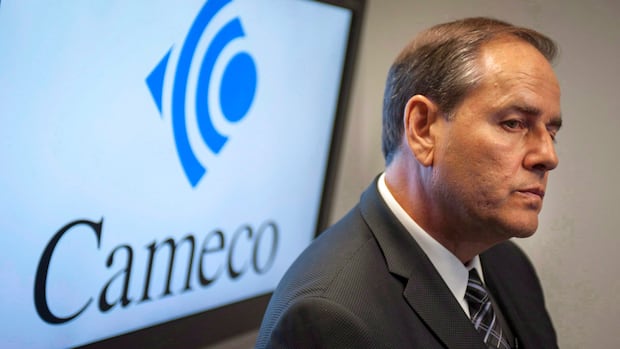Listen to the article
Nuclear industry giant Cameco has clarified that the U.S. government’s involvement in a recently announced $80 billion nuclear reactor deal does not extend to its core uranium mining operations, addressing what the company calls “misinformation” circulating since the partnership was revealed last week.
During a third-quarter earnings call on Wednesday, Cameco CEO Tim Gitzel emphasized the limited scope of the government’s participation in the massive nuclear expansion initiative. “The U.S. government partnership interest does not extend to Cameco’s core business,” Gitzel told analysts, though he noted that the company’s uranium products and fuel services are “well positioned to support the build-out and long-term operation of the global fleet as it grows.”
The landmark agreement, announced last week, will see the U.S. government provide financing and streamline regulatory approvals for at least $80 billion worth of new nuclear reactors across the United States. These facilities will utilize technology from Westinghouse, the nuclear power company jointly owned by Saskatchewan-based Cameco and Brookfield Asset Management.
Cameco’s Chief Operating Officer Grant Isaac described the U.S. government’s role as a “stimulant” for developing the scale of power generation needed to achieve domestic energy security. “The U.S. government is stepping in and saying, ‘It is time. It’s time to get going,'” Isaac explained during the call.
According to Isaac, there are multiple potential structures for the government’s involvement in the nuclear expansion. Options include the government financing plants built and operated by other entities, spearheading its own projects entirely, or creating hybrid arrangements where it builds facilities and transfers them to utilities for operation.
“All options are on the table because the driver here is to get 24-hour baseload carbon-free electrons onto the market as soon as possible in order to meet the onshore demand and meet the [artificial intelligence data centre] demand,” Isaac said, highlighting the growing energy needs driving this nuclear renaissance.
The reactors at the center of the deal will be Westinghouse’s AP1000 pressurized water reactors, which the company describes as the most advanced commercially available nuclear power technology today. Each unit can supply more than one gigawatt of electricity to centralized power grids, making them substantial contributors to the nation’s energy infrastructure.
Isaac also noted that spinning off Westinghouse into an independent company with the U.S. government as a major shareholder remains a possibility. “There is definitely a unique interest in investing just in Westinghouse and Cameco is a funny proxy for that,” he said, acknowledging that the current corporate structure might not be optimal for maximizing shareholder value.
The clarifications came as Cameco announced a 50 percent increase in its annual dividend, raising it to 24 cents from 16 cents. However, the company reported a modest net loss of $158,000 for the quarter ended September 30, compared to a profit of $7.4 million in the same period last year. Revenue from products and services decreased to $614.6 million from $720.6 million year-over-year.
On an adjusted basis, Cameco earned seven cents per diluted share in the quarter, slightly higher than the adjusted profit of six cents per diluted share reported a year earlier.
This massive nuclear expansion initiative comes amid growing recognition of nuclear energy’s role in decarbonization efforts and energy security. The Biden administration has increasingly embraced nuclear power as part of its clean energy strategy, viewing it as essential infrastructure for meeting ambitious climate goals while satisfying increasing electricity demands from sectors like artificial intelligence and data centers.
The partnership represents a significant shift in U.S. energy policy, with the government taking a more direct role in accelerating nuclear deployment after decades of limited new construction in the sector.
Fact Checker
Verify the accuracy of this article using The Disinformation Commission analysis and real-time sources.




8 Comments
Interesting to see Cameco clarifying the scope of government involvement in this major nuclear expansion deal. It’s good they are addressing potential misinformation head-on and highlighting that their core uranium mining business is not directly impacted.
Agreed, transparency around the details of these kinds of large-scale industry partnerships is crucial. Cameco seems to be taking a proactive approach to managing expectations and perceptions.
Cameco’s clarification that the government’s involvement does not extend to their core uranium mining operations is an important distinction. Maintaining that separation will be critical as the partnership evolves.
The $80 billion in new nuclear reactor construction is a significant development for the global energy landscape. I’m curious to see how this initiative unfolds and what it means for the uranium mining and nuclear fuel supply chain.
Yes, this could be a major boost for the nuclear industry. It will be interesting to monitor the downstream impacts on uranium producers like Cameco as the reactor build-out progresses.
While the White House’s role in this nuclear deal is significant, I’m glad to see Cameco emphasizing that their own business remains independent. Avoiding political interference in the supply chain is crucial for the industry.
Agreed. Cameco seems intent on keeping its operations objective and insulated from any potential political influences or perceptions around the government’s involvement.
This is an interesting development for the uranium and nuclear sector. I’ll be watching closely to see how Cameco and other producers navigate the changing dynamics as this major new initiative takes shape.